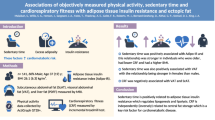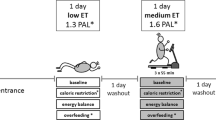Abstract
PURPOSE: To present the evidence concerning the influence of physical activity on the dyslipidaemia of obesity and overweight.
METHODS: Review of a personal library of literature on the interactions of physical activity, lipoprotein metabolism and body fatness.
SUMMARY OF FINDINGS: Obesity, in particular abdominal obesity, is associated with dyslipidaemia—specifically elevated plasma concentrations of triacylglycerol (TAG) in the fasted state, an exaggerated postprandial rise in plasma TAG, low concentrations of high density lipoprotein cholesterol (HDL) and possibly a preponderance of small dense low density lipoproteins. Regular physical activity contributes to the avoidance of overweight and hence to the development of dyslipidaemia. Although low levels of body fatness contribute to the high levels of HDL cholesterol and the low levels of TAG in trained people there are other important determinants of these characteristics. In particular, exercise (and probably training, that is regular, frequent exercise over months and years) enhances the metabolic capacity for TAG, possibly through mechanisms involving increased activity of lipoprotein lipase. This, in turn, has effects on other lipoprotein species such that the transport of TAG and cholesterol in the circulation is improved. There is evidence for a dose–response relationship, with for example, higher levels of HDL cholesterol in men and women who expend more energy in exercise. For the majority of healthy, sedentary adults frequent, moderate intensity exercise equivalent to a total gross energy expenditure of about 8.5 MJ per week is probably a sufficient to influence lipoprotein lipids.
This is a preview of subscription content, access via your institution
Access options
Subscribe to this journal
Receive 12 print issues and online access
$259.00 per year
only $21.58 per issue
Buy this article
- Purchase on Springer Link
- Instant access to full article PDF
Prices may be subject to local taxes which are calculated during checkout
Similar content being viewed by others
Author information
Authors and Affiliations
Rights and permissions
About this article
Cite this article
Hardman, A. Physical activity, obesity and blood lipids. Int J Obes 23 (Suppl 3), S64–S71 (1999). https://doi.org/10.1038/sj.ijo.0800886
Published:
Issue Date:
DOI: https://doi.org/10.1038/sj.ijo.0800886
Keywords
This article is cited by
-
Tetradecylthioacetic Acid Increases Hepatic Mitochondrial β‐Oxidation and Alters Fatty Acid Composition in a Mouse Model of Chronic Inflammation
Lipids (2011)
-
Obesity, atherosclerosis and the vascular endothelium: mechanisms of reduced nitric oxide bioavailability in obese humans
International Journal of Obesity (2002)
-
Serum lipids, serum insulin, plasma fibrinogen and aerobic capacity in obese and non-obese Singaporean boys
International Journal of Obesity (2001)



